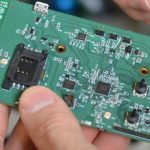Receivers, Where Radio Performance Comes From
We’ve talked about IoT device size and how cellular radio performance and antenna performance are basically constrained by North American carrier performance requirements in opposition to end user expectations of “everything keeps getting smaller”. Now let’s say you spend the time to sort out a size compromise that keeps cell carriers satisfied (note, we didn’t say passing certification) but still leaves you with a viable business case. Congratulations! You may feel like you’ve discovered a miracle… Now for the next major development landmine, interference.
F3’s customers are often companies who have (and want) little to no internal radio frequency (RF) product development expertise or overhead because they simply don’t do enough wireless products to justify a dedicated team. We’ve helped build internal engineering organizations for some companies, and augmented many companies with RF consulting. In general, our customers focus on their core business competencies, which is why they come to us to handle creation of specialized wireless products (or the “Thing” in the “Internet of Things”). The single biggest pain point in radio product development is receiver interference. This is most common, and hardest to fix, in an existing product design that either was never a wireless connected device in the first place or a wireless device that was never subjected to radio performance design verification testing (DVT). In these cases, the design has been painted into a corner so getting out involves more pain than if wireless performance had been considered in the initial design.
Receiver interference is simply the local electronics, the microcontroller, a memory bus, PLLs for various peripherals, switching power supplies etc., creating RF emissions close in frequency to where your receiver is listening. You may have heard the terms self-quieting (which refers to this situation on an FM voice radio), self-interference or self-jamming. It’s important to note that very experienced RF engineers spend a fair amount of time on this exact issue. This isn’t something that happens because you didn’t know what you were doing. This is a common problem in every radio development. An expert only has two or three sources of interference in the design on the first prototype… someone inexperienced will have ten or more. What makes it particularly painful is that the interference sources often overlap, so fixing one out of ten doesn’t show up as an incremental improvement. You often have to fix all of the sources before you see results. This also means that fixing these issues is very time-consuming and unpredictable. It’s not uncommon to spend a month or more addressing this sort of thing even for an expert.
Good Cellular Radio Performance & How to Get There
Often we hear “That won’t be a problem, our device passed FCC or ETSI testing” or, “we’re using a pre-certified radio module”. These are common misconceptions. First, when a non-radio device is tested, it’s tested to ensure it doesn’t generate interference of a level that would bother another device nearby (as in 1-3 meters away). When you put a radio in an embedded device, your radio’s antenna is centimeters away from the rest of your electronics. That distance makes all the difference because the interference gets louder the closer your antenna gets to the source of the noise. What’s acceptable at 1m away cripples your receiver performance at 2cm away. There’s a long list of RF emissions mitigation techniques and best practices that F3incorporates into any design work we do from the beginning. And we also help customers after design work is complete, when they haven’t worked with us from the onset.
With the use of an FCC pre-certified radio module, it’s important to remember that the FCC does not care if your product works. The FCC only cares if you cause interference or harm to people or other devices. As long as you don’t cause interference, you can design, produce, and ship a device that doesn’t technically work; and the FCC is fine with that. Your market and your customer is not fine with that, and negative customer reviews will quickly drive a negative perception in the market. The other issue we see with pre-certified radio modules is that additional FCC certification is still required because radio modules can’t be used near people or other transmitters without additional testing (see our SAR white paper). For things like LoRa, WiFi or BlueTooth, this largely defeats the point of using a radio module in the first place.
Many manufacturers don’t do radiated receiver testing so they wouldn’t know there is a problem. That is, they build a product that has a key performance parameter that’s critical to the device’s market acceptance and commercial success, and they fail to check in the DVT to know how their design performs. They also often don’t check it in production to verify that production units actually function. Common examples are BlueTooth and WiFi based products that use off the shelf or pre-certified radio modules. It’s also not uncommon in cellular devices designed for Europe and Asia where carriers don’t enforce minimum performance requirements. When you do DVT, you should measure every performance factor in the device to ensure it meets basic market requirements. Bringing a new product to market that relies on WiFi and only finding out from your Amazon reviews that the “WiFi range was really bad” or that “the other device I have works much better” is not sound engineering or business strategy.
F3 can help you pick an off the shelf antenna, or design a custom antenna specifically for your design. We can also help with DVT to ensure your product has good performance that meets your market’s expectations. F3’s consulting services can help you address what radio performance metrics should be tested, how to test it, determine threshold for good performance, in addition to what to do if it’s not good enough. Using our production tester IP we develop in-circuit tests and end of line functional test solutions for production so you know you are shipping a good product. If there is one bad placement or wrong value of a part in your RF path, the good performance you worked so hard to achieve in the design is gone. And unless you check it, you won’t know until your product returns come in.
Good radio performance doesn’t just happen. It is complicated and requires attention. You have to test performance when you do your design, even if it’s a purchased radio module. You also need to verify basic RF performance in production, or you risk shipping a product that fundamentally doesn’t work. If your core business isn’t making radio products, F3 can help address these issues so you can focus on what you’re best at.




